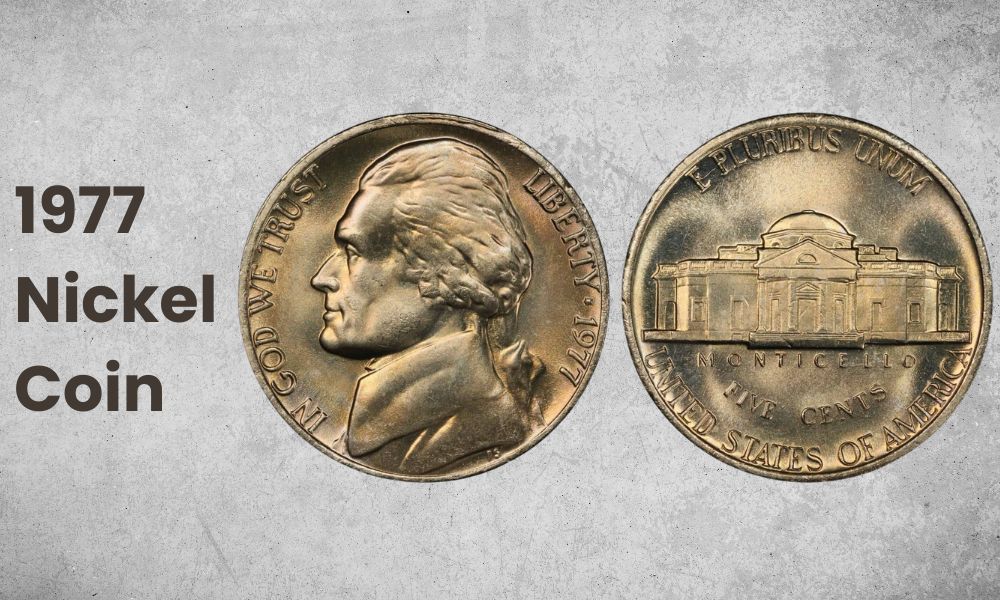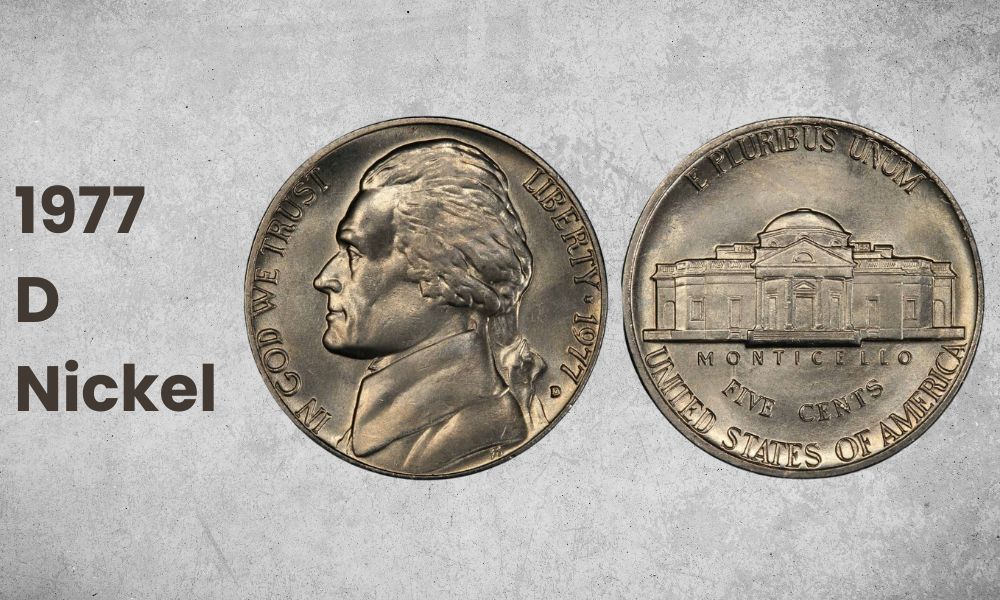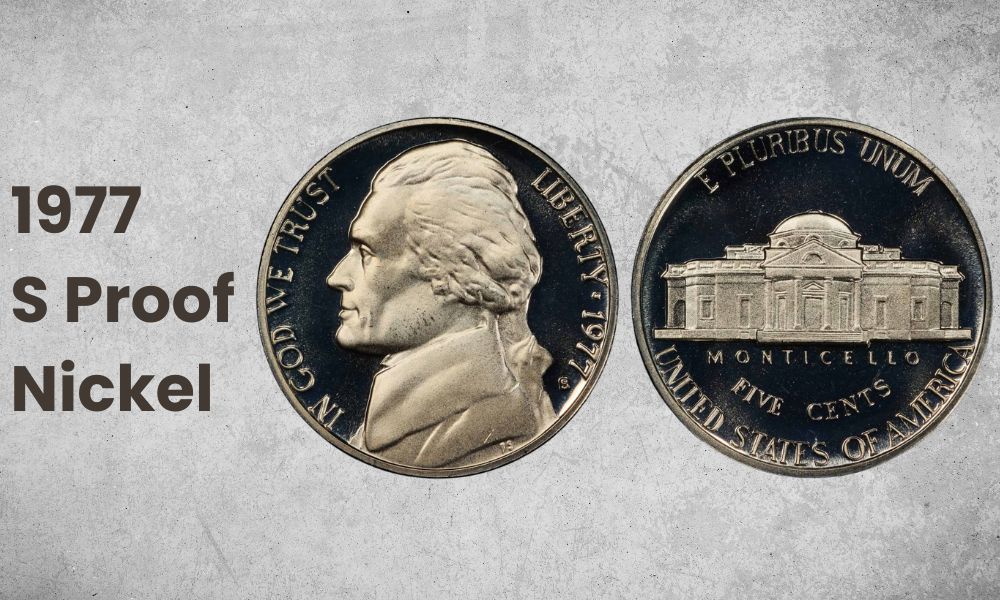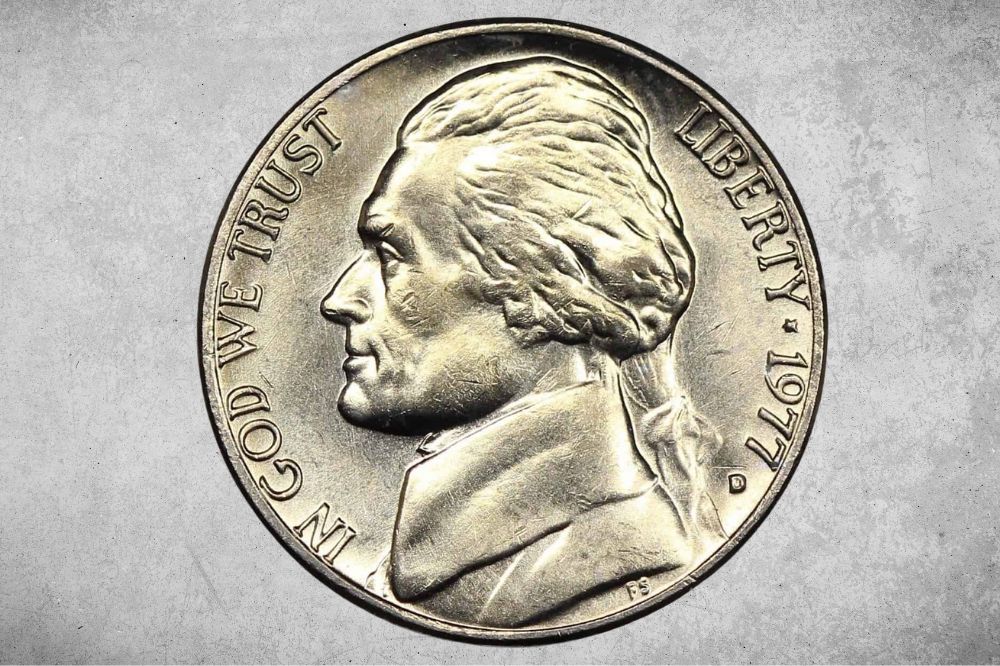Modern Jefferson Nickels were minted in 1965, and most are still in production and use in commerce today. The Jefferson Nickels are one of the best pieces for new collectors since you can complete the entire series from circulating coinage.
Aside from being great for collecting, the 1977 Nickel has a rich history, which only adds to its appeal. Here we will take a deeper look into the 1977 Nickel, including its varieties, value, history, and other important information. Let’s get started!
1977 Nickel Details
- Type: Jefferson Five Cents
- Quantity Produced: 885,940,612
- Designer: Felix Schlag
- Edge: Plain
- Shape: Round
- Coin Diameter: 21.2mm
- Coin Thickness: 1.75mm
- Coin Weight: 5 grams
- Year of Minting: 1977
- Mint Mark: None/D/S
- Place of Minting: Philadelphia, Denver, and San Francisco
- Face Value: $0.05
- $ Price: $0.05 – $4,4495
The Jefferson Nickel was first minted in 1965 and it is still currently in circulation. It has been the longest-running series of the five-cent denomination and it features a portrait of Thomas Jefferson, the 3rd United States President.
In 1938, the coin’s design was introduced, and despite going through numerous design changes throughout the years, it still features Jefferson on it. The bust of the President can be seen on the 1977 Nickels, which are made of 75% copper and 25% nickel.
Uncirculated coins have a diameter of 21.2mm, a weight of 5 grams, and a plain-looking edge. Coins struck between 1938 and 1942 and from 1946 to the present are subject to these specifications. On the back of the coin, to the right of Monticello, was where the mint mark first appeared. The mint mark was shifted to the obverse, below the date, beginning in 1968.
On the front of the coin, Thomas Jefferson is depicted looking to the left with his long hair pulled back with a ribbon. Below his shoulder are the designer’s initials, “FS”, for Felix Schlag. “IN GOD WE TRUST” is written around the left.
The issue year “1977” and the word “LIBERTY” are separated by a five-pointed star in the right-hand corner. You can find the San Francisco or Denver Mint’s mint mark to the right of the image under the last date’s last digit. You will find a small letter D or S for the mint mark.
Monticello is the home that Jefferson built for himself. You can find it on the coin’s reverse center, and it is also framed by a rim. “MONTICELLO” is set underneath the image of his home, while “E PLURIBUS UNUM” is seen at the top-center portion of the coin.
The words “FIVE CENTS” sit underneath “MONTICELLO,” while “UNITED STATES OF AMERICA” can be seen on the lower center portion of the coin.
Also Read: 15 Most Valuable Nickels Worth Money
1977 Nickel Coin Value Chart
| Coin Grade | Good | MS60/PR68 | MS64/PR69 | MS66/PR70 |
| 1977 Nickel | $0.05 | $10 | $30 | $500 |
| 1977 D Nickel | $0.05 | $10 | $50 | $250 |
| 1977 S Proof Nickel | $0.05 | $5 | $20 | $400 |
1977 Nickel Value and Varieties Guides
Since 1970, all nickel pieces were minted at the San Francisco, Philadelphia, and Denver mints. There are regular-strike Jefferson Nickels that feature five or six whole steps across the base of Monticello.
These are scarcer than samples displaying soft strikes across this area of its reverse. Due to the scarcity of these Full Steps Jefferson Nickels, none are known for several dates higher than MS65.
Full Steps Jefferson Nickels are premium valued to comparable grades without designations. For some issues, coins that display full steps can be so rare that they carry massive premiums.
The 1977 Nickels are not made of silver but consist mainly of copper with a balanced amount of nickel. This combination gives the pieces a silver look. The only exception was from 1942 to 1945, wherein the coins contained 56% copper, 35% silver, and 9% manganese.
Doing this was necessary to save on nickel and copper for the war efforts. Additionally, the coins were required to have a huge mint mark on their reverse above Monticello. Let’s see the varieties and values of the 1977 Nickel coins that are available.
1977 Nickel Coin

- Type: Jefferson Five Cents
- Edge: Plain
- Mint Mark: None
- Place of Minting: Philadelphia
- Year of Minting: 1977
- Face Value: $0.05
- $ Price: $0.10 – $4,495
- Quantity Produced: 585,376,000
- Designer: Felix Schlag
The 1977 Jefferson Nickel minted in Philadelphia did not feature a mint mark, and these were also not well-struck.
This resulted in the scarcity of pieces at an MS65 grading. It’s challenging to find coins graded MS66 or higher since these are not often available on the open market. However, these pieces are relatively affordable when it comes to circulated samples.
Full Step coins are even harder to find since these are scarce in any condition. Since only a few samples are available, these coins are underappreciated.
In circulated conditions, you can purchase the 1997 Jefferson Nickel between $0.10 and $0.20. These are still minted today and are actively used in commerce. Plus, most circulated coins are often worth their face value.
For a regular strike of the 1977 Nickel, the record is $1,725 which was sold in 2003. The Full Step coin was sold for $4,495 in 2019.
1977 D Nickel Coin

- Type: Jefferson Five Cents
- Edge: Plain
- Mint Mark: D
- Place of Minting: Denver
- Year of Minting: 1977
- Face Value: $0.05
- $ Price: $3 – $4,320
- Quantity Produced: 297,313,460
- Designer: Felix Schlag
The 1977 D Jefferson Nickel is quite a common piece in most grades. Yet from 1970 to 2007, it had one of the lowest mintages compared to most of the other dates.
Overall, adequate samples were struck, so finding a piece should not be too challenging. Samples up to MS65 are common pieces, but in MS66, these usually become scarcer. In MS67 or higher grades, these are even more scarce since few samples are known.
The coin’s value also depends on its grade, condition, and if the steps are completely struck on the Monticello. Pieces with fully struck steps are called Full Steps or FS. These samples are rare since most coins in this series don’t have a strong strike.
Almost uncirculated coins or lower grades usually cost $0.05 to $0.10, while some uncirculated raw samples are $0.50. Uncirculated 1977 D Nickels in pristine condition are sold at around $200. For the Denver mint, the record is $4,320, and was sold in 2021.
1977 S Proof Nickel

- Type: Jefferson Five Cents
- Edge: Plain
- Mint Mark: S
- Place of Minting: San Francisco
- Year of Minting: 1977
- Face Value: $0.05
- $ Price: $79 – $1840
- Quantity Produced: 3,251,152
- Designer: Felix Schlag
The word “proof” describes a manufacturing process, and not the state of a coin. You can identify proof coins by their sharp details, high wire edges, and shiny surfaces, resembling mirrors.
Highly polished dies are used to create proof coins, and the coinage blanks are cleaned and polished. Each blank receives two or more strikes from the dies to produce sharp, high-relief details as they are manually fed into a coinage press. Slow motion and increased pressure are essential for the process. The result is low-mintage coins with mirror-like surfaces and frosted details.
Most of the 1977 S Proof Jefferson Nickels appeared with great quality, and samples in PR69 Deep Cameo seemed to be the norm. However, it’s scarcer to find those in perfect PR70 Deep Cameo condition. The record for this coin is $1,840, which was sold in 2007.
To get good value for this coin, it’ll need to be in that perfect PR70 condition. Anything less will seriously affect its value. While $1,840 is the record, the average sale price for these coins is around $400.
Also Read: Top 110 Most Valuable Nickels Worth Money
1977 Nickel History
When the Buffalo Nickel had been struck for 25 years and was replaceable without the act of Congress, the mint did not wait. They immediately worked to replace the coin.
Numismatists today favor the Fraser design. However, this was not the case in 1938, and there was no public outcry over the choice. The mint announced an open competition for the new nickel design in January 1938, offering a $1,000 prize to the winner.
While waiting for the 1943 bicentennial of Jefferson’s birth, competitors provided their designs of his portrait to be placed on its obverse. These creations also depicted his house Monticello in its reverse.
On April 24, Felix Schlag was claimed as the winner. His design portrayed Jefferson in a close likeness to the bust of the former President, and it was used on the Nickel coin until 2004. Additionally, his design greatly resembled the work of sculptor Jean-Antoine Houdon, whose piece is housed in Boston’s Museum of Fine Arts.
His model, however, is different from the coin that was struck for circulation. It featured an angled view of Monticello and letterings that officials disliked. Due to this reason, Schlag had to make the necessary changes to both elements.
Due to a misunderstanding or oversight, Schlag did not add his initials to the design and would not be included until 1966.
They were put into circulation on November 15 after the start of production on October 3, 1938. According to historical accounts, people hoarded the Jefferson Nickel. It was not until the year 1940 that the piece was often seen in circulation.
The Coins in WWII and After
Nickel became a crucial war material after the United States entered World War II, so the mint tried to lessen the use of this metal.
Congress approved a nickel with a composition of 50% copper and 50% silver on March 27, 1942. However, it also granted the Mint discretion to adjust the ratios or add metals in the public interest.
The mint eventually found a suitable alloy with 56% copper, 9% manganese, and 35% silver, without nickel content. So from October 1942, this alloy began getting coined into Nickels.
The mint produced all war Nickels with a huge mint mark that appeared above Monticello. They hoped doing this would make the coins easier to sort out and withdraw after the war.
It was the first for the Philadelphia Mint mark (P) to appear on a U.S. coin, but after the war, the old composition returned. All Nickels struck since then had 75% copper and 25% nickel in them.
Also Read: Top 19 Most Valuable Jefferson Nickels Worth Money
1977 Nickel Grading
Coins from throughout the years are all graded via a system of 1 to 70. And if the pieces are older, the more difficult it is to acquire a higher rating. These ratings are often preceded by two letters of either Mint State (MS) or Proof Coins (PF). MS pieces are intended for circulation, so it’s rare to find these coins in perfect condition.
Full Steps is used for circulation strike Jefferson Nickels. These have at least five whole steps, which you can see at the base of Monticello on the reverse. Generally, the term is used to describe coins that have been fully struck. To receive this designation, there should not be any disturbances of the steps caused by contact marks, strike weakness, or planchet problems.
List of 1977 Nickel Errors
It is interesting to note that the 1977 Jefferson Nickel has no known and nationally-regarded errors. That means all possible errors present are on a coin-by-coin basis. The most significant difference is whether or not the coins have the full steps.
1977 Nickel FAQs
1. What nickels are hard to find?
Nickels that are difficult to find in circulation are the 2009 Jefferson Nickels since the pieces saw low mintages. The Philadelphia Mint only produced 39,840,000, while the Denver Mint only had 46,800,000 business strikes.
2. What year did Jefferson Nickels have silver?
The Jefferson Silver Nickel was produced by the U.S. Mint from 1942 to 1945, and it these composed of 35% silver. As struck, each piece consisted of .05626 ounces of this metal. Following the war, the nickels reverted back to a composition of 75% copper and 25% nickel, which is still used today.
3. Are there any rare Jefferson Nickels?
The San Francisco Mint is the mint that produced the fewest number of nickel-copper alloy nickels. Between 1938 and 1964, they struck the Jefferson Nickels and produced only a little over 230 million pieces. Because of the low mintage, the San Francisco Jefferson Nickels are quite rare and difficult to find.
